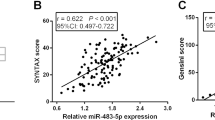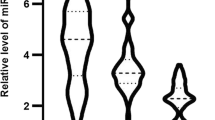Abstract
Background
Recent study reported that microRNA-142 (miR-142) were up-regulated in the atherosclerotic plaques, which may be responsible for pathogenesis of atherosclerosis. However, whether it associates with presence of acute myocardial infarction (AMI), and its prognostic value is still unknown. We, therefore, investigated the association between miR-142 expression and presence of AMI, and its prognostic value in AMI patients.
Methods
We included 300 AMI patients and 100 subjects as the control group. MiR-142 content was detected by quantitative real-time polymerase chain reaction. MiR-142 level was identified in all subjects. The multivariate logistic regression analysis were performed to evaluate the risk factors of AMI. The Kaplan–Meier analysis was performed to determine the major adverse cardiovascular and cerebrovascular events (MACCE)-free survival.
Results
AMI group had significantly higher miR-142 level in comparison to the controls [4.10 (2.03–7.43) vs. 1.92 (0.91–2.91), p < 0.001], moreover, miR-142 content was significantly associated with cardiac troponin I (cTnI) level (r = 0.707, p < 0.001). The MACCE-free survival was significantly lower over 24-month for patients in miR-142 high expression group (72.4% ± 5.6% vs. 76.4% ± 5.1%) (p = 0.022). After adjusting for the traditional risk factors, the odds ratios of miR-142 was 14.74 (95% CI, 2.15–101.24). The multivariate logistic regression analysis revealed that miR-142 level significantly associated with presence of AMI (p < 0.001).
Conclusion
The serum level of miR-142 was increased in AMI patients when compared with health population. Furthermore, use of this marker may allow a certain predictor of the MACCE in AMI patients.



Similar content being viewed by others
References
Thygesen K, Alpert JS, Jaffe AS, Simoons ML, Chaitman BR, White HD, Joint ESC/ACCF/AHA/WHF Task Force for Universal Definition of Myocardial Infarction, Authors/Task Force Members Chairpersons, Thygesen K, Alpert JS, White HD, Biomarker Subcommittee, Jaffe AS, Katus HA, Apple FS, Lindahl B, Morrow DA, ECG Subcommittee, Chaitman BR, Clemmensen PM, Johanson P, Hod H, Imaging Subcommittee, Underwood R, Bax JJ, Bonow JJ, Pinto F, Gibbons RJ, Classification Subcommittee, Fox KA, Atar D, Newby LK, Galvani M, Hamm CW, Intervention Subcommittee, Uretsky BF, Steg PG, Wijns W, Bassand JP, Menasche P, Ravkilde J, Trials & Registries Subcommittee, Ohman EM, Antman EM, Wallentin LC, Armstrong PW, Simoons ML, Trials & Registries Subcommittee, Januzzi JL, Nieminen MS, Gheorghiade M, Filippatos G, Trials & Registries Subcommittee, Luepker RV, Fortmann SP, Rosamond WD, Levy D, Wood D, Trials & Registries Subcommittee, Smith SC, Hu D, Lopez-Sendon JL, Robertson RM, Weaver D, Tendera M, Bove AA, Parkhomenko AN, Vasilieva EJ, Mendis S, ESC Committee for Practice Guidelines (CPG), Bax JJ, Baumgartner H, Ceconi C, Dean V, Deaton C, Fagard R, Funck-Brentano C, Hasdai D, Hoes A, Kirchhof P, Knuuti J, Kolh P, McDonagh T, Moulin C, Popescu BA, Reiner Z, Sechtem U, Sirnes PA, Tendera M, Torbicki A, Vahanian A, Windecker S, Document Reviewers, Morais J, Aguiar C, Almahmeed W, Arnar DO, Barili F, Bloch KD, Bolger AF, Botker HE, Bozkurt B, Bugiardini R, Cannon C, de Lemos J, Eberli FR, Escobar E, Hlatky M, James S, Kern KB, Moliterno DJ, Mueller C, Neskovic AN, Pieske BM, Schulman SP, Storey RF, Taubert KA, Vranckx P, Wagner DR (2012) Third universal definition of myocardial infarction. J Am Coll Cardiol 60:1581–1598
Murray CJ, Barber RM, Foreman KJ, Abbasoglu OA, Abd-Allah F, Abera SF et al (2015) Global, regional, and national disability-adjusted life years (DALYs) for 306 diseases and injuries and healthy life expectancy (HALE) for 188 countries, 1990-2013: quantifying the epidemiological transition. Lancet 386:2145–2191
Thygesen K, Mair J, Katus H, Plebani M, Venge P, Collinson P, Lindahl B, Giannitsis E, Hasin Y, Galvani M, Tubaro M, Alpert JS, Biasucci LM, Koenig W, Mueller C, Huber K, Hamm C, Jaffe AS, Study Group on Biomarkers in Cardiology of the ESC Working Group on Acute Cardiac Care (2010) Recommendations for the use of cardiac troponin measurement in acute cardiac care. Eur Heart J 31:2197–2204
Forberg JL, Henriksen LS, Edenbrandt L, Ekelund U (2006) Direct hospital costs of chest pain patients attending the emergency department: a retrospective study. BMC Emerg Med 6:6
Bidzhekov K, Gan L, Denecke B, Rostalsky A, Hristov M, Koeppel TA et al (2012) microRNA expression signatures and parallels between monocyte subsets and atherosclerotic plaque in humans. Thromb Haemost 107:619–625
Ramkissoon SH, Mainwaring LA, Ogasawara Y, Keyvanfar K, McCoy JP, Sloand EM et al (2006) Hematopoietic-specific microRNA expression in human cells. Leuk Res 30:643–647
Shrestha A, Mukhametshina RT, Taghizadeh S, Vásquez-Pacheco E, Cabrera-Fuentes H, Rizvanov A, Mari B, Carraro G, Bellusci S (2017) MicroRNA-142 is a multifaceted regulator in organogenesis, homeostasis, and disease. Dev Dyn 246:285–290
Wang Y, Ouyang M, Wang Q, Jian Z (2016) MicroRNA-142-3p inhibits hypoxia/reoxygenation-induced apoptosis and fibrosis of cardiomyocytes by targeting high mobility group box 1. Int J Mol Med 38:1377–1386
Sukma DI, Celik S, Karlsson A, Hollander Z, Lam K, McManus JW et al (2017) Exosomal miR-142-3p is increased during cardiac allograft rejection and augments vascular permeability through down-regulation of endothelial RAB11FIP2 expression. Cardiovasc Res 113:440–452
Qin B, Xiao B, Liang D, Xia J, Li Y, Yang H (2011) MicroRNAs expression in ox-LDL treated HUVECs: MiR-365 modulates apoptosis and Bcl-2 expression. Biochem Biophys Res Commun 410:127–133
Bao H, Chen YX, Huang K, Zhuang F, Bao M, Han Y, Chen XH, Shi Q, Yao QP, Qi YX (2018) Platelet-derived microparticles promote endothelial cell proliferation in hypertension via miR-142-3p. FASEB J 32:3912–3923
Wang A, Kwee LC, Grass E, Neely ML, Gregory SG, KAA F et al (2017) Whole blood sequencing reveals circulating microRNA associations with high-risk traits in non-ST-segment elevation acute coronary syndrome. Atherosclerosis 261:19–25
Musher DM, Abers MS, Corrales-Medina VF (2019) Acute infection and myocardial infarction. N Engl J Med 380:171–176
Zhang Y, Li HH, Yang R, Yang BJ, Gao ZY (2017) Association between circulating microRNA-208a and severity of coronary heart disease. Scand J Clin Lab Invest 77:379–384
Xu R, Bi C, Song J, Wang L, Ge C, Liu X et al (2015) Upregulation of miR-142-5p in atherosclerotic plaques and regulation of oxidized low-density lipoprotein-induced apoptosis in macrophages. Mol Med Rep 11:3229–3234
Bao H, Yao QP, Huang K, Chen XH, Han Y, Jiang ZL et al (2017) Platelet-derived miR-142-3p induces apoptosis of endothelial cells in hypertension. Cell Mol Biol (Noisy-le-grand) 63:3–9
Qin B, Shu Y, Long L, Li H, Men X, Feng L et al (2018) MicroRNA-142-3p induces atherosclerosis-associated endothelial cell apoptosis by directly targeting Rictor. Cell Physiol Biochem 47:1589–1603
Karakas M, Schulte C, Appelbaum S, Ojeda F, Lackner KJ, Münzel T, Schnabel RB, Blankenberg S, Zeller T (2017) Circulating microRNAs strongly predict cardiovascular death in patients with coronary artery disease-results from the large AtheroGene study. Eur Heart J 38:516–523
Author information
Authors and Affiliations
Corresponding authors
Ethics declarations
This study comply with the Ethical Standards and informed consent was obtained from all subjects. The study design and methods complied with the Declaration of Helsinki and was approved by the Ethics Committee and Institutional Review Board of Changhai Hospital. The authors declare that they have no competing interests and no funding.
Additional information
Publisher’s note
Springer Nature remains neutral with regard to jurisdictional claims in published maps and institutional affiliations.
Rights and permissions
About this article
Cite this article
Guo, X., Chen, Y., Lu, Y. et al. High level of circulating microRNA-142 is associated with acute myocardial infarction and reduced survival. Ir J Med Sci 189, 933–937 (2020). https://doi.org/10.1007/s11845-020-02196-5
Received:
Accepted:
Published:
Issue Date:
DOI: https://doi.org/10.1007/s11845-020-02196-5




